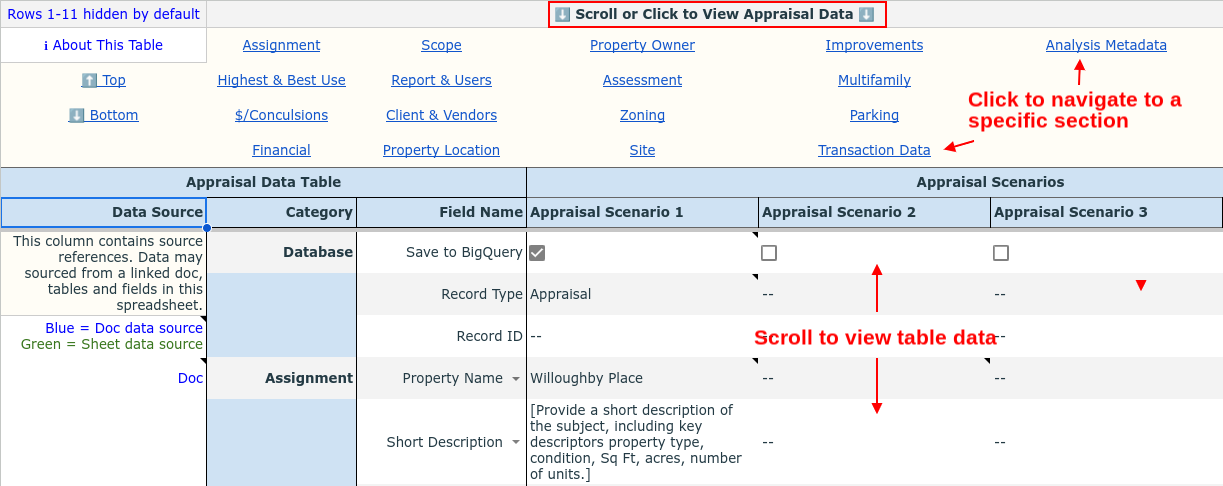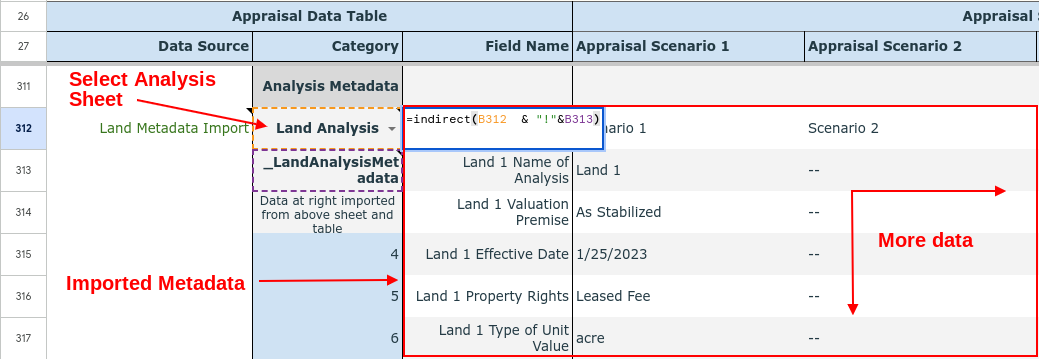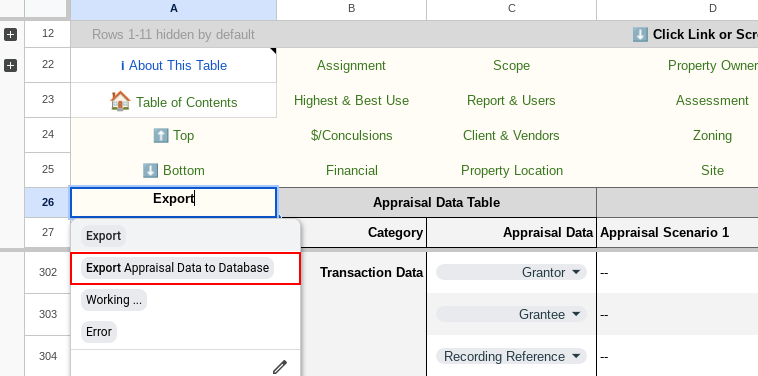Appraisal Data Table Overview
The Appraisal Data table (optional) contains a comprehensive summary for the entire appraisal, from job and client info to final reconciled values and most data points in between. It's a big table with over 400 data fields for up to four appraisal scenarios and a subject transaction. For the most part this table populates automatically and saves to your database easily, but some housekeeping may be required.
While it is optional, it is highly recommended to save appraisal records to your database. This allows you to retain valuable data that can be used in future appraisals, which can improve the consistency, accuracy and efficiency of the process. By saving this data, you can also create a comprehensive historical record of appraisals that can be used for analysis and reporting purposes.
The Appraisal Data table is on the Doc Data sheet, not to be confused with the Appraisal Data Export sheet, which is a transposed copy of the Appraisal Data table for use with other data systems. The former is readable, scrollable and user friendly, the latter is database friendly.
Table Navigation
The table is designed to be scrollable and readable, with fields grouped by typical appraisal sections. Navigate to sections using the links at the top of the table.

Preparing the Appraisal Record
The appraisal record consists of doc data and sheet data. Doc data is mostly ‘front-end’ appraisal data regarding appraisal assignment parameters, subject property description, neighborhood, zoning and highest and best use. Sheet data is the domain for analyses and valuation conclusions; the ‘back-end’ of the appraisal.
Both doc and sheet data populate the Appraisal Data table via lookup formulas. We've done the heavy lifting for you to automate most of this table but there are one or two tasks that may require edits:
- Select the appraisal scenario(s) and if applicable, a subject transaction to save to your database. Typically there are two appraisal scenarios to save: As Is and As Stabilized. A subject transaction may be a listing, offer, contract or sale.
- If you have added additional cost, sales or income analyses add the new analysis metadata to the table.
Select Appraisal Scenario(s) and Subject Transaction #
Select scenarios to be included by selecting the checkbox at the top of the table (row 28) for each valuation scenario. Each selected valuation scenario is saved to your database as a "stand-alone" appraisal record.
If the subject is also a transaction (sale, contract, listing, offer) it will display to the right of the four appraisal scenarios. Transaction data is imported from the Transaction History sheet, while property description info populates from the subject description data (column D). Be sure to edit this data in the transaction column (column H) if it differs from the current property description.
Select the checkbox to save the current transaction when the Appraisal record is saved.

- In the example, the Appraisal Scenario 1 (typically the “As Stabilized”scenario) is selected for saving to the database, and;
- the subject transaction (typically a sale or contract, but could also be a listing or offer) is selected for saving to the database.
Adding Analysis Metadata #
Each sales comparison, income and cost analysis includes a metadata table with up to ~50 data points from the valuation analysis. The metadata includes the number of comps, range of comp dates, low, average, median and high indicators, value conclusions and more. For more information, see About Metadata Tables.
The table is preset to import land, cost, sales, and income analyses metadata, as well as extra sections if additional analyses are added. If you plan to include additional analyses, such as a second sales analysis, you should import the metadata.
Metadata is imported via Google's Indirect function:
=INDIRECT(spreadsheet_url, range_string)
To make this more user friendly, all you need to do is to select the analysis sheet from the drop-down list.

To add a metadata import, scroll down to a blank section for the type of analysis and select the sheet name.

Saving the Appraisal Record
Save selected Appraisal Data to your database by using the drop-down menu in cell A26, at the top-left of the table. The default value is "Export". Select "Export Appraisal Data to Database”to run the export.

Saving the appraisal record should only be done when the appraisal is complete. Appraisal records can be re-saved, which will over-write/update previously saved records.
Appraisal Data Export Sheet
The Appraisal Data Export sheet contains a transposed copy of the Appraisal Data table. This is useful for export/import to third party databases.
Related Articles
Appraisal Data Schema, Data Views and Lists
How to Get More Help
- Email support@startdeck.com
- Request a web meeting here

